Jodhpur
Thursday 30 December –
Saturday 1 January 2000
 By early afternoon, we had
arrived in Jodhpur and eventually found ourselves on the long winding road that
leads up the hill to the Umaid Bhawan Palace Hotel. Arriving at the gated entrance, we would have been justified
in thinking we’d booked into Buckingham Palace for the next three nights but
this was India, as magnificent as it is squalid.
Designed by
By early afternoon, we had
arrived in Jodhpur and eventually found ourselves on the long winding road that
leads up the hill to the Umaid Bhawan Palace Hotel. Arriving at the gated entrance, we would have been justified
in thinking we’d booked into Buckingham Palace for the next three nights but
this was India, as magnificent as it is squalid.
Designed by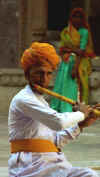 the president of the British Royal Institute of
Architects for the Maharaja Umaid Singh, work started on the marble and pink sandstone
structure in 1929 (Depression? What Depression?) and took 15 years to complete.
After the Maharaja’s death, the building was turned into a hotel with
the spacious grandeur of something built for Royalty.
the president of the British Royal Institute of
Architects for the Maharaja Umaid Singh, work started on the marble and pink sandstone
structure in 1929 (Depression? What Depression?) and took 15 years to complete.
After the Maharaja’s death, the building was turned into a hotel with
the spacious grandeur of something built for Royalty.
The city of Jodhpur is situated
on the edge of the Thar Desert and, after Jaipur, is the largest city in Rajasthan.
It is dominated by a massive fort, which straddles a sheer rocky ridge
right in the centre of town.
All across the old city, indigo painted houses stand out bright and
colourful. Traditionally, blue
signified the home of a Brahmin but more recently, non-Brahmins have also taken on
the tradition, perhaps in part as it is believed that the color worked as an
effective mosquito repellent!
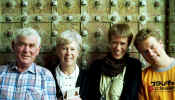 Although a walk through the
jumble of winding streets within the old city, alive with stalls, traffic and
continuous noise, was fascinating in itself, the main attraction of Jodhpur was
without doubt the Meherangarh or Majestic Fort. Set atop a large hill, it could be seen for miles around.
Inside, there
Although a walk through the
jumble of winding streets within the old city, alive with stalls, traffic and
continuous noise, was fascinating in itself, the main attraction of Jodhpur was
without doubt the Meherangarh or Majestic Fort. Set atop a large hill, it could be seen for miles around.
Inside, there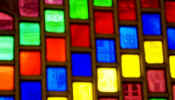 was a series of courtyards and palaces.
The palace apartments housed exhibits of all kinds from Rajput armoury,
furniture and costumes to elephant howdahs (seats), miniature paintings and even
cradles.
was a series of courtyards and palaces.
The palace apartments housed exhibits of all kinds from Rajput armoury,
furniture and costumes to elephant howdahs (seats), miniature paintings and even
cradles.
As we walked
around on New Year's Eve day, we saw
preparations being made for the grand party that night and felt
extraordinarily privileged that as guests at the Umaid Bhawan Palace Hotel, we
had the opportunity to attend the party “by invitation of Their Highnesses the
Maharaja and Maharani of Marwar – Jodhpur”.
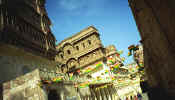 Upon purchase of an extortionately priced ticket of course!
The invitation tried to add a little flavor to the much awaited
celebrations, setting the scene in an oh-so-flowery Indian way by observing that
we would be “in a procession that will transport you to the medieval ages in a
wave of color and sound; rising to a crescendo as the last moments of this
Millennium approach and the 21st Century surges forward to carry you
into the future of hope, harmony and happiness”.
Obviously this was a party not to be missed.
Upon purchase of an extortionately priced ticket of course!
The invitation tried to add a little flavor to the much awaited
celebrations, setting the scene in an oh-so-flowery Indian way by observing that
we would be “in a procession that will transport you to the medieval ages in a
wave of color and sound; rising to a crescendo as the last moments of this
Millennium approach and the 21st Century surges forward to carry you
into the future of hope, harmony and happiness”.
Obviously this was a party not to be missed.
That night, we were driven up to
the historic Fatehpol (Victory Gate) and gathered to await the arrival of the
Maharaja. The massive wooden doors
of the gate were tightly closed, keeping us in suspense as to what lay in wait
for us behind them. To the left of
the gate was a makeshift bandstand with musicians in white uniforms trying to
get their fingers around old Christmas favorites such as 'Jingle Bells' and 'Rudolph the Red Nosed Reindeer'. Suddenly, the tempo changed and the band produced an off-beat
waltz (the significance of which we never did figure out), as the
Maharaja and his family rolled up in a gleaming vintage Rolls.
After a few words of welcome,
inviting us to join him in the procession to the ramparts of the fort, he beat
on the face of the immense wooden doors barring our way to the interior and, abracadabra, the doors opened to an unforgettable scene of regal pageantry.
Waiting inside were several bejeweled camels and horses all dressed up in
traditional Rajput finery. Around
them swirled dancers, their faces hidden, their dresses swirling, while the
men made merry with their drums and flutes.
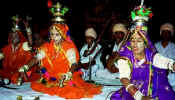 Following
the Maharajah, we made our way slowly up the
incline into the inner reaches of the fort, passing under bridges and walking
beside high ledges where yet more woman dancers were swirling to
musical accompaniments provided by the ring of musicians sitting cross-legged on
the ground around them. Rose petals
were strewn in our path, lilts of different tunes mingled in the air, and the
light of hundreds of candles and torches flickered and gleamed in the night,
casting shadows across the cobbled path and high stone
walls. It was mesmerising.
In fact, it was hard to take it all in, the colours, the different shades
of light, the smells, the noises all making up a part of this fantasy-like
scenes unfolding before us.
Following
the Maharajah, we made our way slowly up the
incline into the inner reaches of the fort, passing under bridges and walking
beside high ledges where yet more woman dancers were swirling to
musical accompaniments provided by the ring of musicians sitting cross-legged on
the ground around them. Rose petals
were strewn in our path, lilts of different tunes mingled in the air, and the
light of hundreds of candles and torches flickered and gleamed in the night,
casting shadows across the cobbled path and high stone
walls. It was mesmerising.
In fact, it was hard to take it all in, the colours, the different shades
of light, the smells, the noises all making up a part of this fantasy-like
scenes unfolding before us.
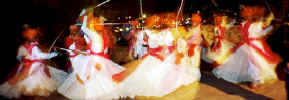
Half way up there was a pit stop
where glasses were refilled and energy was recharged for the final ascent.
As we reached the top, just before the final flight of steps that led us
up onto the magnificent ramparts, we were bedazzled with yet more forms of
entertainment. Traditional puppet
shows were in progress, acrobats whirled through the air performing cartwheels
and somersaults, and fire-eaters and magicians weaved their way through the
crowd: a feast for the senses.
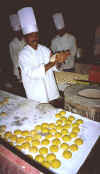 At the top of the ramparts, we
looked down the sheer drop below us to the city, its lights flickering and
casting a peaceful glow upon the night sky.
A line of cannons ran along the length of the ramparts, embedded in the
stone, their barrels facing out over the city.
Waiters passed among the throng of people handing out food and drinks and
we were now free to wander through the many rooms and palaces that were open to
us. Many of the rooms were strewn
with cushions and adorned with swaths of cloth hung between the walls.
Hundreds of tiny oil lamps lined the pathways between
At the top of the ramparts, we
looked down the sheer drop below us to the city, its lights flickering and
casting a peaceful glow upon the night sky.
A line of cannons ran along the length of the ramparts, embedded in the
stone, their barrels facing out over the city.
Waiters passed among the throng of people handing out food and drinks and
we were now free to wander through the many rooms and palaces that were open to
us. Many of the rooms were strewn
with cushions and adorned with swaths of cloth hung between the walls.
Hundreds of tiny oil lamps lined the pathways between 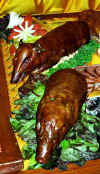 the palace rooms,
and in one of the smaller courtyards a bar and disco had been set up to welcome
in the new millennium. But the
biggest feast of all was the immense barbecue that had been set out in the large
courtyard. From cold cuts to whole
roasted pigs, there was something for everyone.
Salads of all descriptions lined the buffet tables, and there were even
tandoori ovens and tawa hotplates manned by chefs producing fresh, piping hot
breads including traditional naan, chapatis and parathas.
There were as many hot dishes as there were salads and almost twice as
many desserts to choose from, as if you would still have room for more after
sampling all the culinary delights on offer!
It was truly a feast fit for a king.
the palace rooms,
and in one of the smaller courtyards a bar and disco had been set up to welcome
in the new millennium. But the
biggest feast of all was the immense barbecue that had been set out in the large
courtyard. From cold cuts to whole
roasted pigs, there was something for everyone.
Salads of all descriptions lined the buffet tables, and there were even
tandoori ovens and tawa hotplates manned by chefs producing fresh, piping hot
breads including traditional naan, chapatis and parathas.
There were as many hot dishes as there were salads and almost twice as
many desserts to choose from, as if you would still have room for more after
sampling all the culinary delights on offer!
It was truly a feast fit for a king.
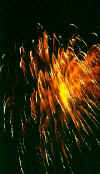 After dinner, there was dancing
and as the new millennium dawned, a spectacular fireworks display above the ramparts. Our
necks craning to look high up into the sky above us, we saw rocket after rocket
lighting up the night sky. Below us
in the city, smaller firework displays were also in progress, and it was a
bizarre sensation to be looking down on them as they burst open,
spreading their colors across the backdrop of the city rather than the sky
itself. Firework safety was
seemingly not the number one priority of those in charge of pyrotechnics at the
fort, and we were both thankful and amazed that none of the men setting them off
were harmed; it seemed at times as if the rocket would take one of them with it
as it whizzed up into the air, a line of fire erupting from its tail.
After dinner, there was dancing
and as the new millennium dawned, a spectacular fireworks display above the ramparts. Our
necks craning to look high up into the sky above us, we saw rocket after rocket
lighting up the night sky. Below us
in the city, smaller firework displays were also in progress, and it was a
bizarre sensation to be looking down on them as they burst open,
spreading their colors across the backdrop of the city rather than the sky
itself. Firework safety was
seemingly not the number one priority of those in charge of pyrotechnics at the
fort, and we were both thankful and amazed that none of the men setting them off
were harmed; it seemed at times as if the rocket would take one of them with it
as it whizzed up into the air, a line of fire erupting from its tail. 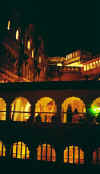
After the fireworks, dancing
once again became the order of the day and more prizes were announced for 'the
best dressed couple' or 'the most outrageous dancer' of the evening.
We were impressed by the prizes being offered: weekends at exclusive
resorts in Goa; a two night stay at the best hotel in Delhi; or a boondoggle at
a sister
hotel of the Umaid Bhawan elsewhere in the country.
It seemed well worth making a fool of yourself on the dance floor if
those were the kinds of things you could win.
But soon, the last of the prizes had been handed out and only one
remained, for the 'Millennium Couple'. Intrigued
by what they would be handing out for this apparently top prize of the evening,
we decided to hang around and see what the winners got to take home.
Finally, the judges had made their decision and announced that the
Millennium Couple of 2000 would be …. Eric and Pippa!!!!
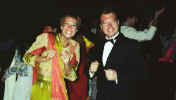 Apart from being somewhat taken
aback, we suddenly got very excited. Could
we be taking home a free weekend at a top resort in Goa?
Or maybe a few extra nights at the Umaid Bhawan?
We stepped up to the podium, brimming with anticipation.
But this time, instead of a plain white envelope (like the one that had
contained the weekend in Goa), there were two wrapped gifts.
“Some jewelry for Pippa” the man announced (wow, a diamond necklace,
maybe?), “and, for Eric, some traditional Indian clothing” (a pang of
disappointment, but whatever it was would probably be made of the finest silk).
We thanked him profusely. On
regaining our former positions, next to Pippa’s brother and parents, we
unwrapped our prizes with a great sense of excitement.
And the prizes? Well, tacky,
plastic costume jewelry for the woman who never wears jewelry, and a cotton
nightgown for the man who could have won the prize for 'most non-Indian body
type'. Oh for that weekend in Goa.
Apart from being somewhat taken
aback, we suddenly got very excited. Could
we be taking home a free weekend at a top resort in Goa?
Or maybe a few extra nights at the Umaid Bhawan?
We stepped up to the podium, brimming with anticipation.
But this time, instead of a plain white envelope (like the one that had
contained the weekend in Goa), there were two wrapped gifts.
“Some jewelry for Pippa” the man announced (wow, a diamond necklace,
maybe?), “and, for Eric, some traditional Indian clothing” (a pang of
disappointment, but whatever it was would probably be made of the finest silk).
We thanked him profusely. On
regaining our former positions, next to Pippa’s brother and parents, we
unwrapped our prizes with a great sense of excitement.
And the prizes? Well, tacky,
plastic costume jewelry for the woman who never wears jewelry, and a cotton
nightgown for the man who could have won the prize for 'most non-Indian body
type'. Oh for that weekend in Goa.
When we arrived back at the
hotel in the early hours, our New Year celebrations were far from over.
Courtesy of CNN, we had brought in the first new year of the millennium
with the people of Kiribati earlier
that 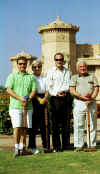 afternoon. This time, we tuned
in to watch our New Year celebrations back home, and at around 05.00am saw the
fireworks along the Thames in London, followed later that morning by the crystal
ball falling at Times Square in New York and finally, in the early afternoon,
put a call into Eric’s family in California to wish them a Happy New Year as
their new millennium dawned almost half a day later.
afternoon. This time, we tuned
in to watch our New Year celebrations back home, and at around 05.00am saw the
fireworks along the Thames in London, followed later that morning by the crystal
ball falling at Times Square in New York and finally, in the early afternoon,
put a call into Eric’s family in California to wish them a Happy New Year as
their new millennium dawned almost half a day later.
Needless to say, no-one surfaced
until early afternoon on New Year’s Day when we gathered at the restaurant on
the pillared terrace overlooking the gardens to eat and decide what to do with
our day. We ended up deciding on a
game of croquet which lasted the rest of the day and which Pippa’s mum lost,
courtesy of her son in law!
Osiyan
Sunday 2 January 2000
The next morning, there were
several tearful goodbyes as Pippa’s mother and father left to return to Delhi
and then London while we, still accompanied by Pippa’s brother, Jerry, headed
further west to Jaiselmer in another rented car (complete with reckless driver).
We headed first for the town of
Osiyan, a great trading centre between the 8th and 12th
centuries when it was dominated by the Jains.
We arrived as night was falling and with limited options on
accommodation, found ourselves in a deserted pilgrim hostel, courtesy of the
head priest at the Jain temple. We
had read in the guidebook that there was a range of tented accommodation
available at a nearby Camel Camp but at $200 a night, the novelty of sleeping
under canvas diminishes rapidly. Instead,
we warmed ourselves on cardamom tea and coffee, then went to visit the temple in
darkness. A family had rented
the temple for the evening (by means of a hefty donation) in order to hold a
vigil for a recent family member who had died.
They were singing and praying but nonetheless welcomed us in to join
them. With no electricity inside
the temple, shadows from the flickering oil lamps danced around the temple.
Amid this eerie atmosphere, we felt very self conscious looking around at
the magnificent carvings and sculptures while this seemingly unstructured
ceremony unfolded. People would
come and go, sometimes halting proceedings to presumably ask a question or
inform others of something that had happened. After brief consultation among
themselves, the chanting would recommence and random bits of music from a bell
or drum would float out into the night air.
After half an hour or so, we
bade our goodnights and made our way back to the hostel, telling the priest we
would be back the following morning to take some photos of the exterior.
That night, we ate at the roadside with our driver, huddled round a
makeshift fire which was kept alive with anything that could be burnt – paper,
cardboard boxes, even soles of old shoes – and learning more of the culture in
this fascinating country while locals looked on in wonder.
We were up early the following
morning, admiring the temple in the light of day. Jainism arose around 500 BC, around the same time as Buddhism,
and although they displaced Hinduism in central and northern India for a time,
Hinduism continued to be the principal religion in the south.
Unlike the Buddhists, however, the Jains never really denied their Hindu
heritage and their faith never extended beyond India.
A significant amount of
painstaking restoration was taking place, which, given the level of detail in
the Osiyan sculptures, was apparently slow to progress. Even though we had already seen what is considered to be the
greatest Jain temple in India at Ranakpur, we were still impressed by the
quality of carvings here. The only
thing that gave us pause was why the female body appeared in so many
scantily-clad and provocative guises within the confines of a temple. The priest explained to
us that it was through the experience of sin that the Jains believed they evolved learning to
renounce the desire which tainted all human experience. Good answer!
Jaisalmer
Monday 3 January - Tuesday 4
January 2000
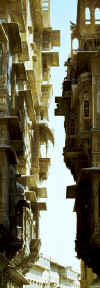 We arrived
in Jaisalmer by
mid-morning and as we approached, marveled at this giant sandcastle look-alike
rising out of the middle of the desert. Centuries
ago, Jaisalmer’s strategic position on the camel train routes between India
and Central Asia meant it acquired significant wealth, hence allowing the
townspeople and merchants to build magnificent houses, exquisitely carved
from wood and golden sandstone. With the
rise of shipping trade, Jaisalmer declined in importance but nowadays
was making a big comeback with tourism.
We arrived
in Jaisalmer by
mid-morning and as we approached, marveled at this giant sandcastle look-alike
rising out of the middle of the desert. Centuries
ago, Jaisalmer’s strategic position on the camel train routes between India
and Central Asia meant it acquired significant wealth, hence allowing the
townspeople and merchants to build magnificent houses, exquisitely carved
from wood and golden sandstone. With the
rise of shipping trade, Jaisalmer declined in importance but nowadays
was making a big comeback with tourism.
This was perhaps the only
negative side to Jaisalmer. Aesthetically,
it was a wonderful place to wander. The
massive fort rose above the city, a warren of narrow, paved streets
brimming with Jain temples and the old palace of the former ruler.
Unlike any of the forts we had seen previously, this one was an integral
part of the city. Guesthouses,
restaurants, shops and homes could all be found within the gates, hidden
down the many alleyways. In fact,
about a quarter of the city’s population resided within the fort walls; this
was in brilliant contrast to the empty palaces housing small-scale museums
elsewhere. 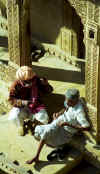
Beyond the fort was the old city,
situated within the old city walls. There
were yet more winding streets and many fine examples of the old sandstone
mansions built by the wealthy merchants of Jaisalmer, known as h.
Some displayed exquisite carvings in wood or sandstone.
Just outside the city walls was the old water supply to the city
surrounded by many small temples and shrines.
It was a peaceful walk around the lake and gave us a chance to reflect on
how much we had enjoyed our visit to Jaisalmer.
Despite the huge influx in tourism (and with it, the burgeoning business
in restaurants serving banana pancakes), Jaisalmer had retained a unique
ambiance.
Bikaner
Wednesday 5 January – Friday 7
January 2000
From Jaisalmer, we took a bus
northeast to Bikaner, 30 kilometres (20 miles) south of which lay our destination: the Karni Mata Temple,
better known as the 'Temple of Rats'. Here, rats are considered to be
incarnations of mystics or ancestors, and are brought offerings of food by a steady stream of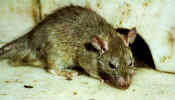 believers. There are literally thousands of rats running riot throughout the temple complex,
and they like visitors. Definitely not for the squeamish.
believers. There are literally thousands of rats running riot throughout the temple complex,
and they like visitors. Definitely not for the squeamish.
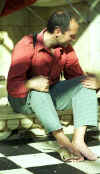 We knew we would have to leave
our shoes at the door (as with all other temples), although at the threshold the idea of not having any
protection against these esteemed vermin became less than appealing.
But we were not leaving before we’d seen this for ourselves, and within
a second of stepping foot into the inner courtyard, a black rat sped across our
paths. Then, we saw more … and
more of these oh-so-revolting rodents.
The floor was writhing with them, a sea of black fur, long tails and
protruding incisors.
Avoiding them was hopeless, but, as our driver had advised us, it was a
stroke of good fortune to have one run across our feet so we stood, eyes closed,
toes curled as soon as we
We knew we would have to leave
our shoes at the door (as with all other temples), although at the threshold the idea of not having any
protection against these esteemed vermin became less than appealing.
But we were not leaving before we’d seen this for ourselves, and within
a second of stepping foot into the inner courtyard, a black rat sped across our
paths. Then, we saw more … and
more of these oh-so-revolting rodents.
The floor was writhing with them, a sea of black fur, long tails and
protruding incisors.
Avoiding them was hopeless, but, as our driver had advised us, it was a
stroke of good fortune to have one run across our feet so we stood, eyes closed,
toes curled as soon as we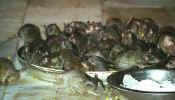 were close enough for them to be swarming round our
ankles. Large bowls of food, both
inside the temple and in the courtyard itself, were teeming with rats of all
sizes. The guidebook noted that
eating this holy food that has been salivated over by the rats also
apparently brings good luck but that we were definitely not going to try.
were close enough for them to be swarming round our
ankles. Large bowls of food, both
inside the temple and in the courtyard itself, were teeming with rats of all
sizes. The guidebook noted that
eating this holy food that has been salivated over by the rats also
apparently brings good luck but that we were definitely not going to try.
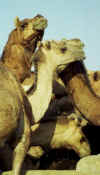 But the big excitement of our
visit was spotting the white rat. Our
driver had told us that any wish we made would come true were we to see this
highly auspicious temple resident. Locals
were crowding round a doorway where it had been spotted, trying to entice it out
with food. The air was electric,
each and every person willing this rodent out of its hole in order to cast good
fortune on all those who saw it. We were soon rewarded with a very positive sighting of this
holy rodent, resplendent in his whiteness from head to tail.
And what did we wish for? Well,
we had just learned Pippa was pregnant, and wished for a healthy baby ... and in
September, a strapping baby girl was duly born. So we can heartily
recommend the white whiskered wonder of Bikaner.
But the big excitement of our
visit was spotting the white rat. Our
driver had told us that any wish we made would come true were we to see this
highly auspicious temple resident. Locals
were crowding round a doorway where it had been spotted, trying to entice it out
with food. The air was electric,
each and every person willing this rodent out of its hole in order to cast good
fortune on all those who saw it. We were soon rewarded with a very positive sighting of this
holy rodent, resplendent in his whiteness from head to tail.
And what did we wish for? Well,
we had just learned Pippa was pregnant, and wished for a healthy baby ... and in
September, a strapping baby girl was duly born. So we can heartily
recommend the white whiskered wonder of Bikaner.
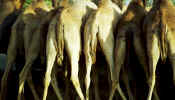 Before leaving
town, we paid a visit to the Camel Research and Breeding Farm and learnt all about these
weird and majestic creatures. We
also visited the fort (a must do in all Indian cities that have them) and took
a long wander through the city.
We were rewarded with sightings of some spectacular havelis and old Jain
temples but after one day, we’d seen pretty much all there was to explore and
the next morning were on a train to Delhi; a typically long, unremarkable journey.
Before leaving
town, we paid a visit to the Camel Research and Breeding Farm and learnt all about these
weird and majestic creatures. We
also visited the fort (a must do in all Indian cities that have them) and took
a long wander through the city.
We were rewarded with sightings of some spectacular havelis and old Jain
temples but after one day, we’d seen pretty much all there was to explore and
the next morning were on a train to Delhi; a typically long, unremarkable journey.